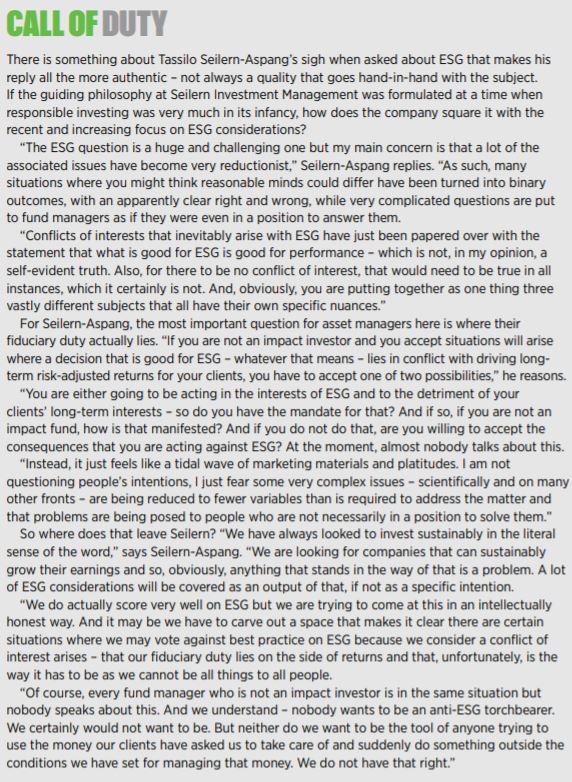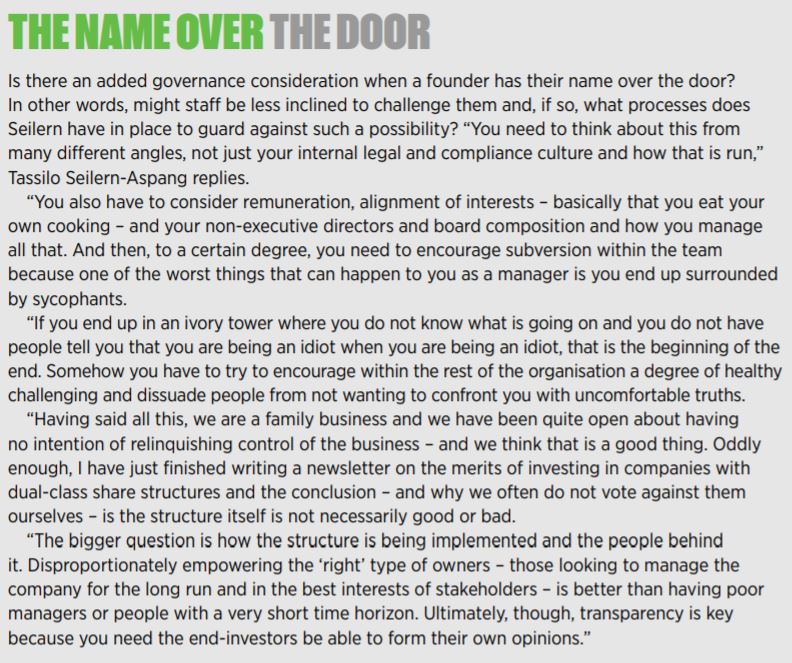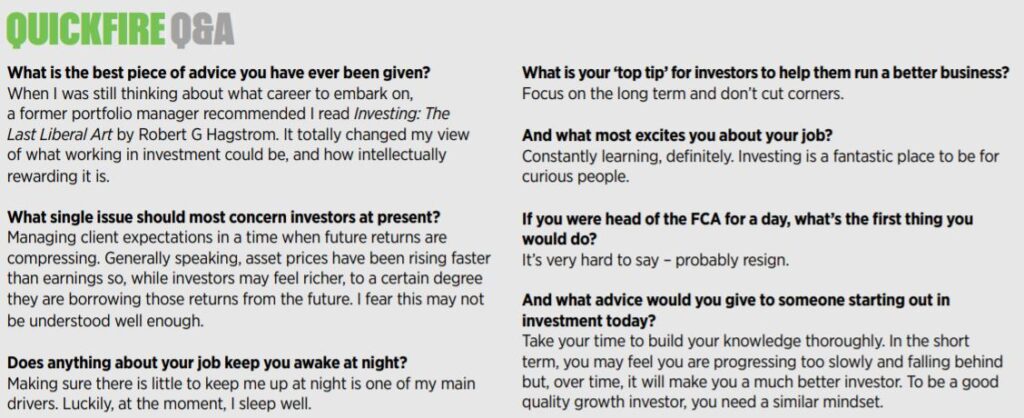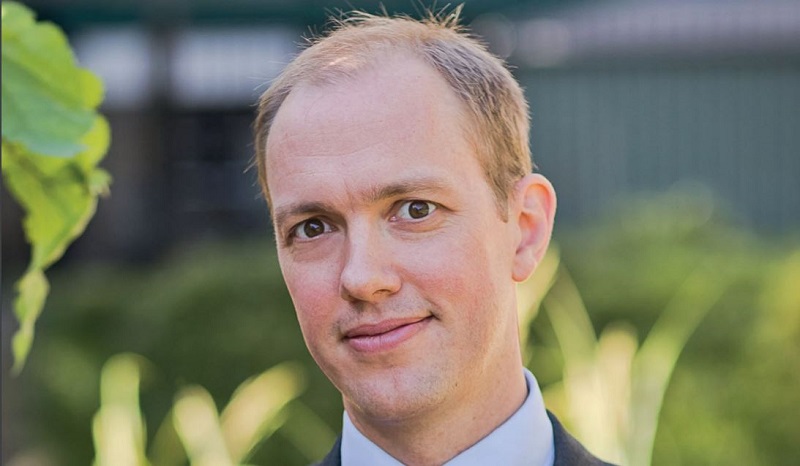Simply put, asset management groups can aspire to one of two goals – try to be all things to all people or focus on one thing and do it well.
Seilern Investment Management – which redefines the idea of ‘selective’ by boiling down its investment universe shortlist of global stocks to just 70 quality growth businesses, with no more than 25 high-conviction choices making it into each of its four portfolios – sits very much in the latter camp.
“Every asset manager faces different issues – you just have to try and use the skills you have to your advantage,” says Tassilo Seilern-Aspang, who joined the firm as an analyst in 2010 and became a fund manager four years later, before being appointed head of research in 2018 and CEO last year. “Large listed players have a di cult time, for example, because you have to keep your investor base happy.
“Your plans need to be very well signalled and you constantly have to go for growth. Arguably, your main asset is your distribution channel so you try and maximise that, which inevitably means you try and compete on cost and size, and you focus on following the flows wherever they go. That changes the type of organisation you can be – and, if you fail, you have to move into M&A as you seek to grow.”
For its part, says Seilern-Aspang, Seilern has been doing the same thing since his uncle, Peter – now chairman and CIO – founded the business in 1989. “Inevitably, we are quite good at what we do because we have spent a long time trying to get it right,” he continues. “So, if you have, say, three or four years to produce something to compete with us in the quality growth space, you will be hard-pressed to come up with a really good product.
“Yet that is what the big players are constantly trying – and while their product does not have to be that good as it will naturally catch some flows, it does create certain challenges because, over time, investors can become disappointed with the average product quality a lot of very large houses offer.
“Added to that, the timeframes the management of listed businesses get to operate with are too short to make a difference over the long run.
“At Seilern, we have the luxury of being able to think now about things 10 or 20 years ahead. Yet, if you have an investor base that is remunerated on yearly performance putting pressure on management to set targets, and if you have a management team likely incentivised with a stock price and an average tenure of maybe seven years, you really do not have much time between devising a strategy, implementing it and reaping any benefits.”
Nor do smaller businesses have it any easier, suggests Seilern-Aspang. “Barriers to entry are rising and rising, and so it is expensive to build up and then keep a good team,” he says. “At the same time, the growing regulatory burden is making it harder and more expensive for smaller players to break out and build their own business – to build up the required track record and distribution channels, attract the right people and so on.
“That said, the place you really do not want to be is the middle because then you are caught between not having the size entirely to benefit from economies of scale and being too large to really focus on your product – hence why you are seeing so much consolidation in that part of the market. So, as I say, everybody has their own sets of problems to deal with.
“You have to figure out the strengths you have for where you are and how to maximise those to tilt the odds in your favour. If, like us, you are relatively well-funded and you think long-term, you do not necessarily have to take every investor who wants a massive discount and you can just patiently build up your business. And, if you are in a position like that, you can be fairly well insulated against your own set of pressures.”

Founder’s dilemma
One particular issue facing a founder-led business, such as Seilern, is how to pass on the ownership flame without putting noses out of joint. “Part of the challenge for any founder is how to ensure your company outlasts you and works for the long run,” says Seilern-Aspang. “The other part is how to ensure everybody is motivated correctly and prioritised appropriately.
“The issue that normally arises with a founder-led business is a natural tension between the founder, those who went on to build up the business and those who are running it now – in the sense of who is really entitled to how much? There can be different permutations of answer for different businesses but what is very unlikely is all three parties will agree on how much each of their contributions is worth.
“That, if you like, is the perceived power relationship between the different parts of the business, but then there is the legal element – who actually has the power to implement things? That will normally lie with the founder, who can either retire and try and hold on through that or look to sell up. And if they sell up, they might get a very good price but, inevitably, the other two parts will feel hard done by and demotivated and probably leave.
“That is why it is very unusual to see asset management companies sold for the right reason – they are normally sold because there is a mismatch, basically, between the legal power of the people selling and the de facto influence they have within the business. And, by the same token, asset management companies are rarely bought for the right reason – because most people who buy them should know this is the case.
“Nevertheless, they buy because they want to increase volumes or to feel like they are doing something – all the while keeping their fingers crossed. So, in that sense, selling is not really an option – and it is not anything that we as a family business ever wanted to do anyway. Instead we set out to break the usual power laws you see within an asset management business and just made every person in this company a shareholder.”
Anyone aspiring to create an asset management business for the long run cannot build it on individuals such as star fund managers, argues Seilern-Aspang. “You need to build it on a process and the remuneration structure must clearly reflect that,” he continues. “You cannot say you will build on a process but still have the managers of the largest fund take home the largest share of the profits.
“So our fund managers have the same remuneration package, as it were, even though one may manage $100m (£73.4m) and another $2bn – and that is accepted because it is accepted the process drives the output; that the decision-making process is collegiate; and their contribution is the same. That makes the business less dependent on individuals and also takes a lot of the pressure off the fund managers.
“Then, no matter how many owners retire, since the lion’s share of the profits is always spread across the team, you create that stability, which should allow for a smooth transition from one controller to the next. That, of course, is just about the profit pool – on the control side, we are very clearly a family-controlled business with partners and we have a very long view of how we want to manage things.
“So we are very patient, thinking in terms of decades and seeing our role as a neutral mediator between the existing shareholders. We are looking to ensure things are managed fairly and for the long run and that one group of shareholders does not abuse its position and try and to pull the rug to their side and knock the whole system out-of-kilter.”

Talk about evolution
Clearly the Seilern team believe they have found a way of doing business that works well and are sticking by it, but how can they be sure any investment philosophy remains fit-for-purpose? Does it evolve? “The philosophy does not evolve but the process will,” clarifies Seilern-Aspang. “Indeed, it is constantly evolving because you make mistakes through the years and then you fix them – you have to be constantly averaging up.
“It is a very simple philosophy: look to identify good businesses that grow – where you have a high chance of calling that right and forecasting it for the long run – and then you hold them and let them drive the earnings for you. Most businesses – though not all – will undervalue longer-term cashflows so, if you buy and hold, you have a relatively high degree of certainty they can grow for the long run and that will drive your future returns.
“That philosophy and the core principles of our process – arriving at the Seilern universe of stocks our managers can invest in – are absolutely immutable. What changes, though, is the environment you are in and then obviously you need to adapt the process to that. New types of businesses arise and we try and find the best ones that fit into our investment philosophy, and construct our portfolios accordingly.
“But adapting to circumstances is not the same as compromising or changing our investment style, it just means the implementation will yield a different crop of investee companies and we must constantly learn about all the new developments. We look to keep everybody on a steep learning curve and put them in an uncomfortable position – in a way they can handle, of course – because that is how you learn the most.
“Our philosophy is set in stone, our process – in terms of what it is trying to achieve – is set in stone, the implementation adapts all the time and the output probably changes the most because it is a result of what the economy can offer us – and that changes. As such our track record – insofar as anyone’s track record is worth anything – will not necessarily be much of an indication of how the funds will behave in the future.”
Turning to the future of asset management as a whole, Seilern-Aspang worries that while “the general education level for maths is too low and many things are done that are mathematically unsound”, the sector is the opposite. “The asset management industry has become increasingly obsessed with statistics and what is measurable,” he says. “And within the ‘what is measurable’, it is not taking into account the quality of data.
“I see it, for example, in the CFA curriculum, in the dominance of modern portfolio theory, in the approach of the regulator and in the real weight quantitative risk management has in the whole risk management process. And the fact this is now received wisdom and the self-perpetuating way the industry is educating new entrants is a problem because, from an accounting point of view, the quality of the data is getting worse.”
The reason for this deterioration in data quality, Seilern-Aspang argues, is businesses are becoming increasingly intangibles-based and thus much harder to value. “Both tangibles and intangibles have ways of being capitalised onto the balance sheet and that can definitely create opportunities,” he goes on. “But as the industry goes more and more the way it is, I see a problem arising for companies like us.
“We put all our resources into making a qualitative assessment of businesses and the cashflows they generate but then there is increasing pressure to overlay a quantitative risk management process, which to-tally subverts everything you have done. Yes, comfort can be drawn from numbers because they are fixed but, if the quality of those numbers is low, you are just fooling yourself that risk is being managed.
“And I think the industry has gone too far down that route – from individual investment analysts all the way up to asset allocators, risk managers and the way the regulator thinks about all this. I am not saying it does not have its uses – just that the way it is being implemented has surpassed the utility that can bring.
“This industry has become overly reliant on statistics and ascribes to them more than they can actually deliver.”








